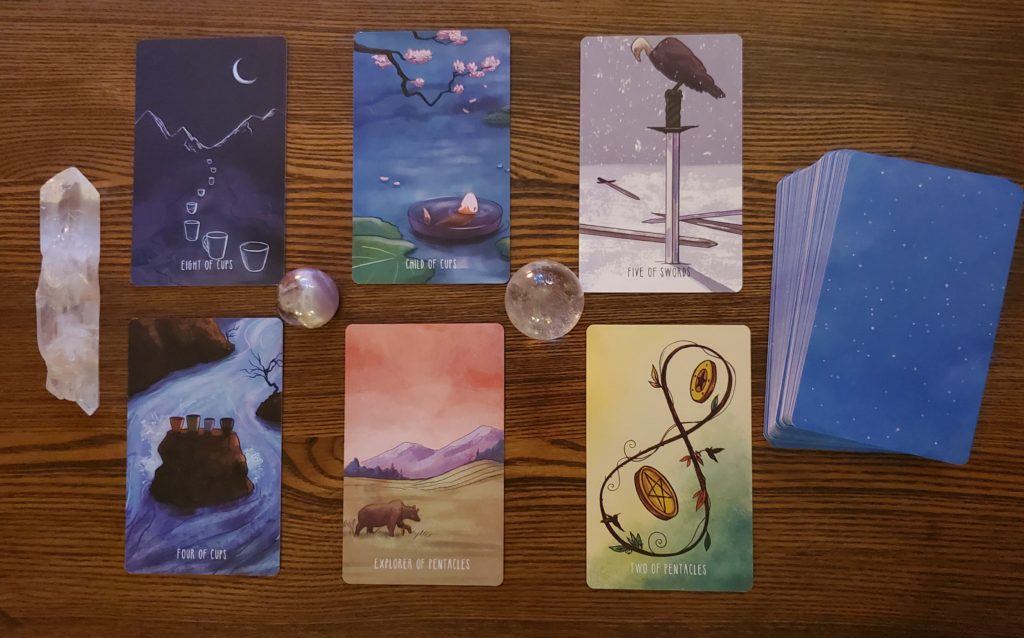Your cart is currently empty!
by
Last updated:
Tarot Deck Review – the Spacious Tarot, 2nd Ed.

I’ve had the Spacious Tarot deck on my deck wish list for the better part of a year, and finally was able to get a copy of the 2nd edition over the holidays, and am delighted to share and recommend it to you all!
The artwork grabbed my attention as soon as I saw images of it online – beautiful, sparse landscapes that leave plenty of room (appropriately enough) for your imagination and intuition. Although full of images from the natural world (and containing no people) I would not call this a nature-focused deck. It feels more like a storybook with room to fill it with your own life story. Beautiful and inspiring.
The images on the cards all bleed to the edges with no border of any kind. The feel is a clean, colorful look that manages to grab traditional tarot imagery in a unique, fresh way. The card titles are at the bottom for both the Major and Minor cards in a simple, easy-to-read (if small) font.
The cards have a lovely texture and weight – not overly thick, but sturdy. They have a matte finish that lets the cards glide well when shuffled, but isn’t so slick that the cards constantly slide off each other. The deck is slightly smaller than most (70 x 112mm) making it the smallest deck in my collection, with the exception of my one playing-card sized deck. The are a terrific fit for my small hands!
The back is a mottled light blue flecked with light dots of varying colors and sizes, recalling a starry sky slowing lightening toward dawn. It’s certainly not unappealing, but feels a bit bland -not my favorite.
The Guidebook is ample (137 pages) with a nifty introduction to how the tarot is structured in general. This goes beyond what is usually found in most LWBs, and dives into the 3-tiers of the Major Arcana (Rachel Pollack’s structure from 78 Degrees of Wisdom), the elements of the suits, meanings of each number devoid of suit, and the stations of the court cards. It is, in short, a mini version of my introduction to tarot class, lol! The information is brief, giving a few keywords and phrases for each concept so it doesn’t feel overwhelming.
Each of the Major cards are given about a page and 1/2, with the Minor cards each on a single page. No pictures are given for any of the cards, which is standard for a guidebook the same size as its deck.
Deck Structure
The deck has the standard 78 cards, with the Majors all titled with (more or less) traditional titles. The Minors have the standard suits – Wands, Cups, Swords, and Pentacles – and the court card stations are:
- – Child
- – Explorer
- – Guardian
- – Elder
The court cards are represented by an animal-specific to each suit:
Wands – Salamanders
Cups – Koi Fish
Swords – Crows or Ravens
Pentacles – Bears
I find it intriguing that crows and ravens are such popular choices as a symbol to represent suits. The Lightseer’s Tarot also uses crows/ravens for the suit of swords (although, unlike other decks, the Spacious Tarot only uses these creatures for the court cards of each suit – not the numbered cards). The Raven’s Prophecy Tarot has ravens in the suit of Cups, and the Badger’s Forest Tarot uses them as Pentacles. I’ll have to dig into the importance of corvids (the family of birds crows, ravens, and jays belong to) in tarot in a future article.
Reading

Reading with the Spacious Tarot was refreshingly simple. Not a lot of complex imagery to ponder or reference, making it easy to just pick up and read intuitively without going over the guidebook first. Which I always do anyway – I’m always curious to hear what artists and/or deck creators have to say about their work. But I like not feeling like the imagery is so esoteric or complex that it’s unattainable without initial guidance.
I read with the New Deck Interview Spread (from Little Red Tarot), pictured above, starting with this deck’s most important characteristic: the 8 of Cups – moving away from everyday comforts to seek your spiritual path. The Spacious Tarot can be a strong tool for that work. Its strengths are in the Child of Cups – wonderment and an open-hearted attitude. The Spacious Tarot can help us listen to our intuition, and to learn and expand our capacities.
This deck’s limits? The 5 of Swords. Defeat. Betrayal. No single magical tool is should something we put all our hopes and efforts into – this deck is no different. Its limits are our own. If we diversify the tools we use for spiritual growth we will see stronger results due to using different mirrors and filters in our work. Blind spots can develop otherwise, no matter how genuine our efforts are.
What are you here to teach us? The 4 of Cups -how to keep ourselves engaged and in the energetic flow of the world. To help us come back to our soul work when we’re struggling with detachment. How can we best learn and collaborate with you? Explorer of Pentacles. Slow and steady progress – our partnership will take time to build, but ultimately this deck can be a strong tool in our spiritual growth toolbox.
What is the potential outcome of our working relationship? 2 of Pentacles. Flexibility, balance. Helping our spiritual workflow in a healthy, balanced, and productive way.